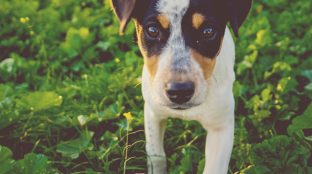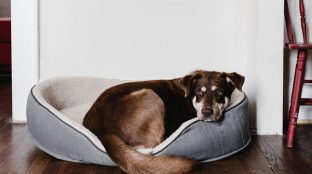Guide to Moving House with a Dog

This guide will give you lots of practical advice to make moving home with a dog easier for you, your family and your favourite canine friend. It’s not just about dogs moving house either, it’s about getting them to their new home safely, settling in and what happens afterwards.
So we’ll be showing you how to familiarise your dog with your new home and reduce the risk of it escaping and going back to your old house too.
Moving dogs isn’t rocket science, but it can add to the stress of moving home if you don’t plan ahead and prepare your dog for what to him or her might be unexpected if not scary. Dogs are territorial and come moving day will probably still be as attached to their home as you once were, but by following a few simple steps you can make the move more enjoyable.
There are four stages to moving house with dogs:
- Before you leave
- Preparing your dog for a long journey
- Arriving and settling in
- Stopping your dog from returning to your old house
Each stage is important and needs careful consideration and preparation; skip a stage and you might end up with a pouting pooch, but plan it properly and everyone’s in for an easier ride.
Before you leave
Like any territorial creature, dogs enjoy spending time in a familiar environment, and any sudden change to their surroundings or being moved away from it – even temporarily – can upset them. This is why maintaining a sense of familiarity and safety is key. Make sure your dog is micro-chipped too and tell the company your new address so they don’t think your dog’s run away. It’s the safest way to ensure they can be found if they do escape or try to return to their old territory.
- Choose a “safe room” in your current house. This is where your dog can spend its time while the movers are packing and loading the lorry. Put some of your dog’s favourite things inside this room: blankets, bedding, furniture, toys or other items you know it likes to have nearby. Keep this room closed on moving day so your dog can’t escape or be spooked by seeing unfamiliar people coming and going. If you have a cat too, it might be best to keep them in different rooms depending on how well they get along.
- Tell your movers about the safe room and to leave it ‘til last.
- Pop in occasionally to give your dog some reassurance and TLC. When all the other rooms are packed and loaded, close your front door. If your dog has become anxious or over-excited at all the commotion then it might try to escape the moment you open the safe room door. If all is well, go through your usual “leaving the house” routine and ask someone else to pack up the last few items from the safe room.
- If a safe room isn’t an option, consider a kennel. That way, there’ll be no risk of your dog becoming nervous or running off.
Preparing your dog for a long journey
For long trips (more than two hours) you might need to do a bit more preparation than you normally would. However near or far, maintaining a sense of familiarity is still important:
- Use a secure and comfortable cage or harness and include a favourite toy or other items your dog likes
- You’ll need enough food and water to last the trip too – dogs dehydrate, just like we do
- Partially opening the window, especially if you stop on the way, will also help keep your dog comfortable and cool.
The Blue Cross veterinary charity has some excellent advice about travelling with dogs:
- Make sure your dog is healthy before you travel
- Never transport your dog in the boot, loose in the front foot well, or in the removal van
- On long journeys, stop and offer your dog water, a chance to exercise and go to the toilet
- NEVER leave the dog inside a hot car if you stop for a break
Arriving and settling in
Moving a dog means taking them away from an environment they know well and placing them into a new and unfamiliar territory: that change can be a stressful experience for them. If it proves too much, your dog might try to return to its previous home, even on the first night. To help reduce the chances of your dog trying to return to its old home, do the same as when you left your old house:
- Choose a safe room and place items in it that your dog will find familiar
- Then place your dog inside and close the door while you move everything else in
- Pop in from time to time to check they’re ok
Make sure the safe room includes the following items to help them feel more comfortable:
- Their basket or other items they would associate with comfort and safety
- Toys to play with – moving in can take a while so keeping your dog stimulated will help it adjust
- Keep the temperature constant and if you can, similar to your old home
The RSPCA also has some very useful tips and advice for creating the right kind of environment for your dog for example:
- If you’ve got more than one dog, provide them all with enough toys, food, water, beds etc. to stop them from becoming competitive and fighting.
- Living in a cold or wet place can make your dog unwell. Give your dog a comfortable, dry, draught-free, clean and quiet place to rest undisturbed.
- Dogs are inquisitive and can get into dangerous situations if left unsupervised. Make sure that where your dog lives is safe, secure and free from hazards.
Stopping your dog from returning to your old house
It can take several weeks for your dog to become familiar with, and feel secure in, your new home and the surrounding environment. Double check your new garden for holes in the fence or gaps between the shed, where your dog might wriggle through and escape. When it’s time to introduce your dog to the neighbourhood, which might not be on the same day you move in, follow these steps:
- Go through your usual “leaving the house” routine
- Use a lead or harness at all times if you’re worried there is a risk your dog will try to run off
- Keep a lookout for other dogs on your walk, which won’t know your dog or vice versa
- Keep the walks short at first, just round the block for example
- Do this every day, extending the amount of time your dog explores
Before you know it, your dog will feel safe and secure in its new home, garden and neighborhood.
One last thing…
It’s well worth leaving a picture of your dog and your contact details with the people moving into your old home too. If your dog does escape and return there, they’ll be able to let you know but tell them not to feed it, or do anything which might encourage it to spend any more time there.






Call our team of experts on 0800 521541 and get your quote today!
Why choose Robinsons?
-
Market leading
We provide a fast, convenient, reliable and professional service that makes use of the latest materials and technologies. This makes us stand out from the crowd.
-
Years of experience
We’ve been helping people move and store their personal belongings for more than a century. This has equipped us for any eventuality on moving day.
-
Putting you first
Our customer-focused approach is what sets us apart in the removals industry. Excellent customer service is at the heart of everything we do.
-
Flexible service
Our staff want to make moving house as simple for you as possible, whatever your requirements. Speak to one of our team today and they'll talk you through the Robinsons process.
